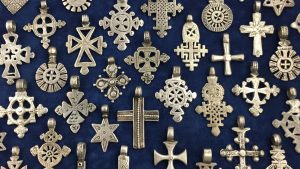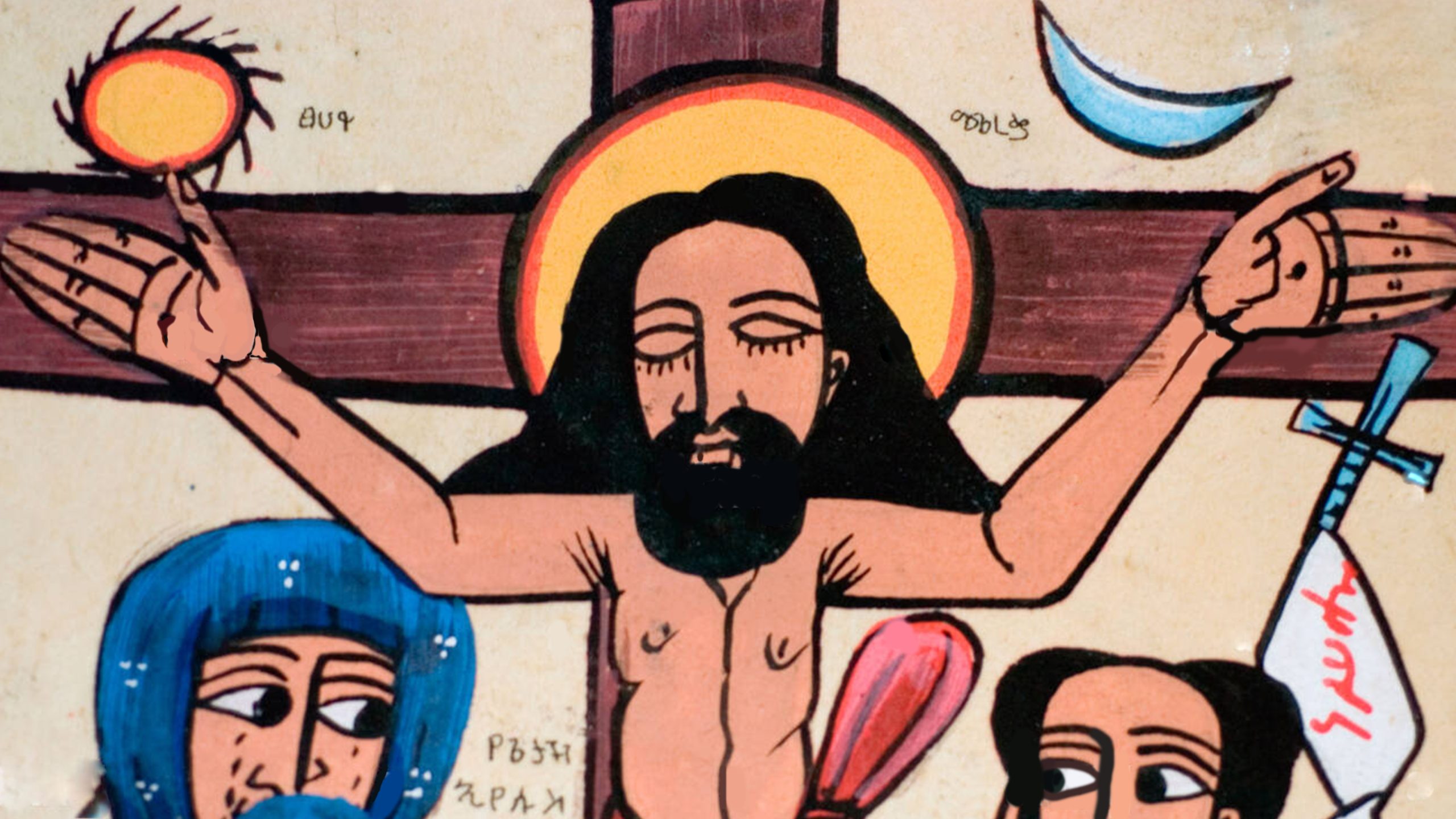
Get Up to 15% OFF Store wide – Limited time only
Menu
Get Up to 15% OFF Store wide – Limited time only

Ethiopian art is a profound tapestry of sacred symbols, stories, and cultural heritage, a unique expression of a people deeply connected to their faith, history, and the natural world. From religious icons and crosses to illuminated manuscripts, textiles, and monumental architecture, Ethiopian art speaks to themes of resilience, devotion, and a distinctive cultural identity. Today, Ethiopian artists continue this legacy by blending ancient symbols with contemporary themes, ensuring that Ethiopia’s visual language remains alive and relevant to new audiences.
Ethiopian art has ancient roots, with the introduction of Christianity to Ethiopia in the 4th century under King Ezana marking a significant cultural shift. This early adoption of Christianity created a unique visual tradition centered on both religious and cultural expressions. “Ethiopian art is more than a reflection of the past; it is an enduring expression of devotion,” says Aida Fekadu, an Ethiopian art historian. “Each symbol and story embedded in Ethiopian art reflects a continuity of faith and cultural pride passed down through generations.”
Ethiopian art uses a symbolic visual language, where figures, colors, and forms transcend aesthetics to serve a deeper purpose. Whether as a devotional object, a historical record, or a cultural emblem, Ethiopian art grounds Ethiopian identity in a shared spiritual and artistic
heritage.
The Ethiopian cross is one of the most iconic symbols in Ethiopian art, celebrated for its intricate, interlocking designs. Unlike the simpler crosses of other Christian traditions, Ethiopian crosses are highly detailed, with lattice-like patterns crafted from silver, brass, or iron. Each
region of Ethiopia has its unique cross style, such as the Lalibela cross with its woven patterns and the Axum cross with geometric symmetry, symbolizing the unity of Ethiopia’s diverse communities.
“The Ethiopian cross is more than a Christian symbol,” Fekadu explains. “Its unbroken, continuous design represents eternity and the boundless connection between the human and the divine.” Ethiopian crosses are used in religious ceremonies, worn as jewelry, and displayed as art, embodying resilience, faith, and a cultural identity that connects Ethiopia’s regions and communities. Adulis Ethiopian Art is dedicated to sharing these symbols with the world, bridging Ethiopian spirituality and artistry with global audiences.
Ethiopian illuminated manuscripts are treasured cultural artifacts, crafted by monks and scholars who meticulously combined vibrant illustrations with sacred text. Written in Ge’ez, Ethiopia’s ancient liturgical language, these manuscripts blend Biblical narratives, lives of saints, and prayers with symbolic depictions. Figures in these manuscripts often feature almond-shaped eyes, a signature of Ethiopian iconography that represents spiritual insight and a vision that transcends the physical realm. “These manuscripts are more than books; they are visual hymns,” Fekadu says. “Each brushstroke reflects the creator’s devotion and intent.” The colors—red, blue, green, and gold—
are chosen to signify divine light and spiritual vitality. These manuscripts, carefully preserved in monasteries, inspire with their stories of faith, resilience, and the Ethiopian spirit. By presenting this art to the world, Adulis Ethiopian Art hopes to share the beauty and symbolism embedded in Ethiopia’s rich literary and spiritual traditions.
The Role of Ge’ez Language and Script in Ethiopian Art
The Ge’ez script, often found in illuminated manuscripts and religious artifacts, holds a revered place in Ethiopian art. Known for its stylized, calligraphic forms, Ge’ez serves as both a functional language and an art form. “The Ge’ez script is a powerful symbol of Ethiopia’s
spiritual and intellectual heritage,” Fekadu explains. In Ethiopian art, Ge’ez transcends its role as a language, becoming a sacred emblem that connects generations through its visual and textual expressions.
Iconography and the Depiction of Saints
In Ethiopian art, saints and holy figures are portrayed with symbolic characteristics: elongated
figures, bold colors, and expressive eyes. Unlike Western religious art, Ethiopian iconography focuses on spiritual symbolism rather than realism. Saints, angels, and Biblical figures are often depicted with direct, front-facing gazes, creating an intimate connection with viewers and inviting them to engage with the artwork on a spiritual level.
“Ethiopian saints and angels are more than religious icons; they are protectors and guides,” Fekadu notes. Their symbols—like crosses, staffs, or scrolls—add layers of meaning, inviting viewers to reflect on the virtues they represent. These icons are found in churches, monasteries,
and homes, establishing a sacred space that connects believers to their faith. Adulis Ethiopian Art strives to preserve and share this unique visual language, fostering a global appreciation for Ethiopian spirituality and artistry.
The Rock-Hewn Churches of Lalibela: Carving Spirituality into Stone
The rock-hewn churches of Lalibela are perhaps the most enduring symbols of Ethiopiandevotion, standing as architectural marvels and spiritual testaments. Carved from volcanic rock in the 12th century, these churches were constructed as a “New Jerusalem” for Ethiopian
Orthodox Christians. Each church, with its cruciform shape and labyrinthine design, symbolizes Ethiopia’s spiritual journey and serves as a testament to Ethiopian resilience and faith.
“Lalibela’s churches are masterpieces of devotion,” Fekadu explains. “They are physicalmanifestations of Ethiopia’s commitment to faith, carved into the landscape as symbols ofresilience and innovation.” These churches remain active sites of worship, drawing pilgrims from
around the world, and serve as a bridge between Ethiopia’s past and present. Adulis EthiopianArt celebrates this legacy by honoring works inspired by Lalibela, connecting contemporary audiences with Ethiopia’s spiritual and architectural heritage.
Ethiopian Textile Art and Symbolism in Weaving
Textile art plays a unique role in Ethiopian culture, with traditional garments like the habesha kemis and netela showcasing complex patterns and colors that symbolize Ethiopian identity. Each region of Ethiopia has its own textile designs, often associated with rituals or social status. “Textile art in Ethiopia is deeply symbolic, representing unity and cultural pride,” Fekadu shares. Weaving traditions are passed down through generations and continue to be a vital part of Ethiopian culture, reflected in contemporary art that blends traditional patterns with modern aesthetics.
Contemporary Ethiopian artists are transforming the use of sacred symbols by reinterpreting them within new mediums. Artists like Elias Sime and Julie Mehretu incorporate elements of traditional Ethiopian iconography into works that explore identity, community, and global
themes. “Modern Ethiopian art preserves heritage while exploring new expressions,” Fekadu explains. Sime’s installations, made with recycled materials, reflect themes of resilience and renewal, carrying Ethiopian cultural symbols into contemporary global conversations.
By reinterpreting sacred symbols, modern Ethiopian artists bridge Ethiopia’s past and present, keeping Ethiopian art relevant while honoring its spiritual roots. Adulis Ethiopian Art shares these contemporary expressions, showcasing a dynamic Ethiopian art that speaks to audiences around the world.
The Influence of Ethiopian Art in the African Diaspora
Ethiopian art has a significant impact on the African diaspora, particularly through symbols like the Ethiopian cross and the Lion of Judah. For many in the diaspora, Ethiopian symbols are markers of pride, resilience, and a shared African heritage. “The legacy of Ethiopian art in the diaspora connects generations through symbols of cultural unity and strength,” Fekadu reflects. This influence is especially strong in places like Jamaica, where the Ethiopian cross has become a symbol of faith and freedom.
Conclusion: Ethiopian Art as a Living Legacy of Sacred Symbols
Ethiopian art remains a powerful testament to the impact of sacred symbols and cultural heritage. From the iconic Ethiopian cross to illuminated manuscripts, textile art, and the rock-hewn churches of Lalibela, each piece of Ethiopian art offers insight into a world where the sacred and artistic are inseparable. Today’s Ethiopian artists continue this legacy, blending traditional symbols with contemporary themes to resonate with modern audiences while honoring their roots.
As Ethiopian art gains global recognition, it invites viewers to explore its layers of meaning and rich narrative of faith, resilience, and unity. In a world that increasingly values cultural heritage, Ethiopian art stands as a symbol of continuity and transformation. Through these works, Adulis Ethiopian Art aims to bridge generations, offering a timeless narrative that celebrates Ethiopian spirituality, culture, and artistry—revealing the beauty of Ethiopian art far beyond the canvas.




Lorem ipsum dolor sit amet, consectetur adipiscing elit, sed do eiusmod tempor incididunt ut labore
We have newsletter every week and new art work every month

Adulis Ethiopian Art celebrates Ethiopia’s rich heritage by connecting talented artists with a
global audience. Join us in sharing the beauty of Ethiopian art with the world.